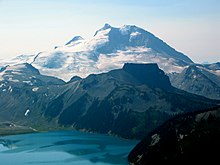


Avolcanic fieldorcrater row is an area of Earth's crust that is prone to localized volcanic activity. The type and number of volcanoes required to be called a "field" is not well-defined.[1] Volcanic fields usually consist of clusters of up to 100 volcanoes such as cinder cones. Lava flows may also occur. They may occur as a monogenetic volcanic field or a polygenetic volcanic field.
Alexander von Humboldt observed in 1823 that geologically young volcanoes are not distributed uniformly across the Earth's surface, but tend to be clustered into specific regions. Young volcanoes are rarely found within cratons, but are characteristic of subduction zones, rift zones, or in ocean basins. Intraplate volcanoes are clustered along hotspot traces.[2]
Within regions of volcanic activity, volcanic fields are clusters of volcanoes that share a common magma source.[3] Unlike a large volcano with satellite or subsidiary vents, a volcanic field's vents have their own source of magma, possibly of different compositions (such as basalt and rhyolite), and these vents may span an area of thousands of square miles.[4] Scoria cones are particularly prone to cluster into volcanic fields, which are typically 30–80 kilometers (19–50 mi) in diameter and consist of several tens to several hundred individual cones. The unusually large Trans-Mexican Volcanic Belt has nearly 1000 cones covering an area of 60,000 square kilometers (23,000 sq mi).[5]



'Volcanic Field' is a term commonly used to describe a group of small, monogenetic and dominantly basaltic volcanoes, but that often includes groups of mixed monogenetic and polygenetic edifices. Besides ambiguities on the type of edifice that should be considered to form a VF, there is a lack of agreement concerning the number of volcanoes required to define a VF (ranging from five to over 1000), it is uncertain if the area covered by the volcanoes forming a VF must have a minimum number of volcanoes/unit area, or if the distance between adjacent structures needs to have a specific length. Furthermore, in many cases, it is uncertain whether some area is occupied by two adjacent fields or if it is occupied by two subgroups belonging to a unique field.
| Authority control databases: National |
|
|---|
This volcanology article is a stub. You can help Wikipedia by expanding it. |